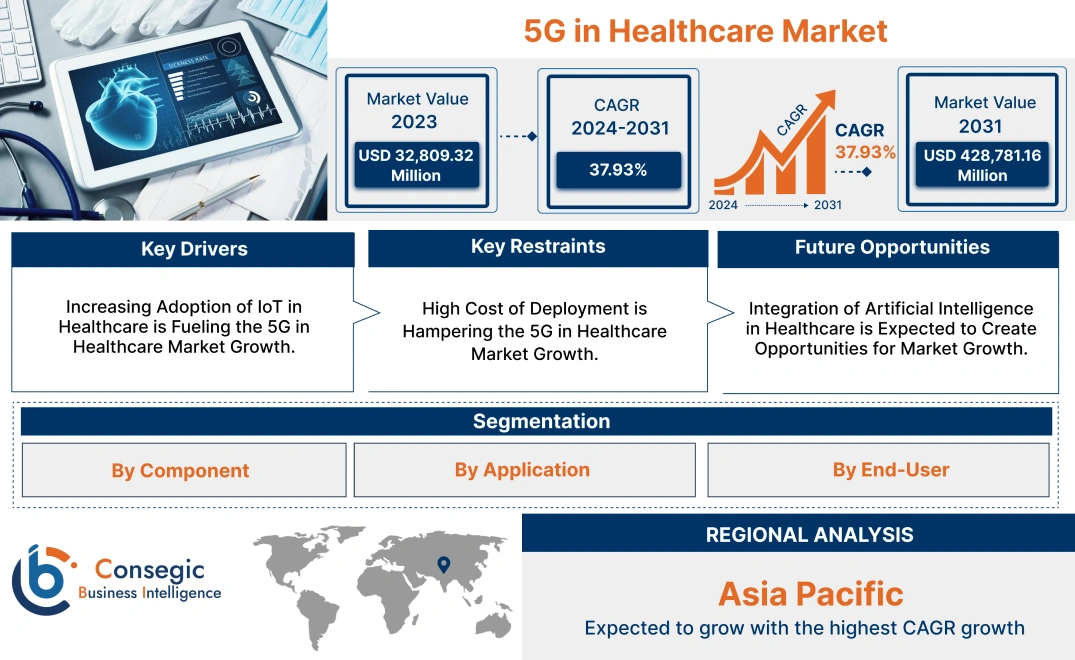5G in Healthcare Market Size:
5G in Healthcare Market size is growing with a CAGR of 37.93% during the forecast period (2024-2031), and the market is projected to be valued at USD 428,781.16 Million by 2031 from USD 32,809.32 Million in 2023.
5G in Healthcare Market Scope & Overview:
5G in healthcare refers to the integration and application of fifth-generation wireless technology within healthcare systems, medical services, and medical devices among others. It is used to enable highly reliable, low-latency communication, high-device connectivity, and high-bandwidth data transmission. This supports advancements in medical care, remote health services, and digital health innovations among others. 5G's high-speed, low-latency connectivity enables seamless communication between healthcare providers and patients. It facilitates the rapid transmission of large amounts of medical data enabling timely diagnosis and providing treatment. Hence, 5G is widely employed for several applications including telehealth, healthcare information systems, augmented reality (AR) and virtual reality (VR), and connected medical devices among others.
5G in Healthcare Market Dynamics - (DRO) :
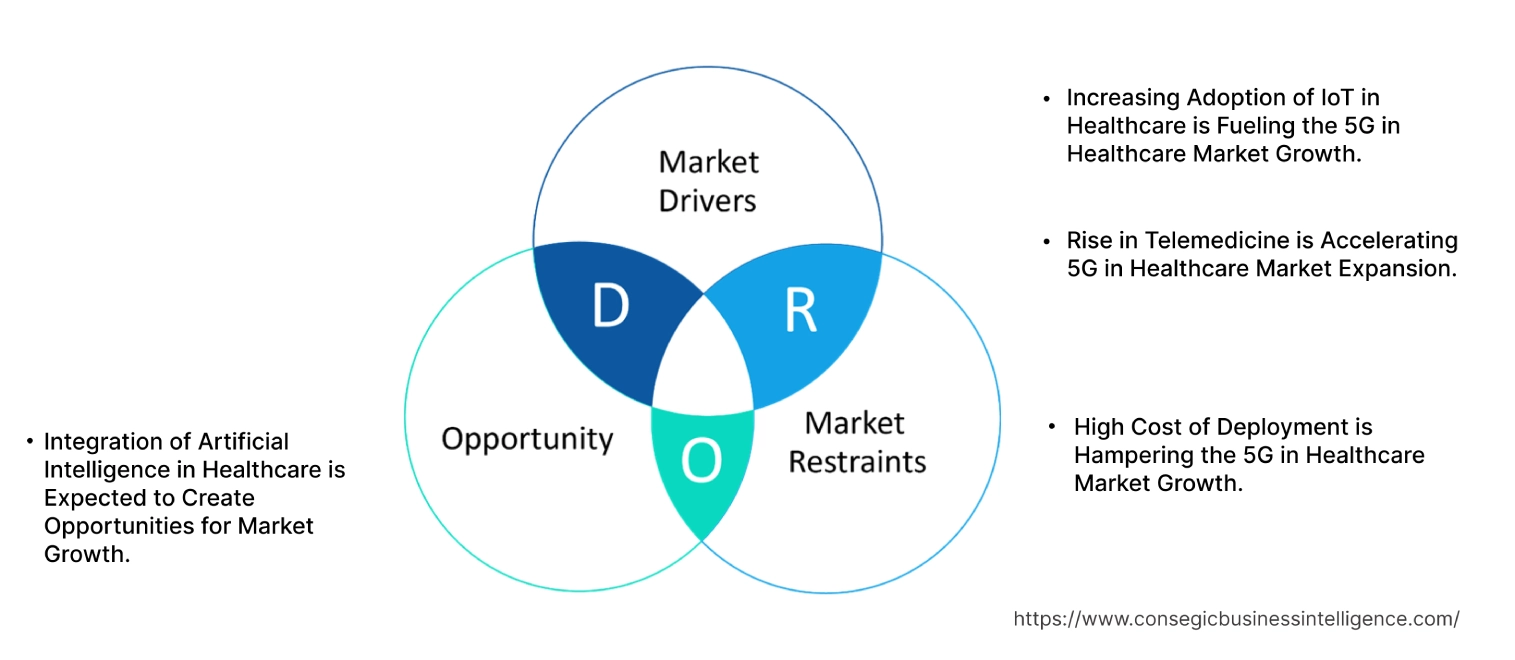
Key Drivers:
Increasing Adoption of IoT in Healthcare is Fueling the 5G in Healthcare Market Growth.
The rapid adoption of the Internet of Things (IoT) in healthcare represents a fundamental transformation in the healthcare sector, serving as a prominent factor for the 5G in healthcare market expansion. IoT refers to the collective network of connected devices and the technology that facilitates communication between devices and the cloud, as well as between the devices themselves.
The adoption of IoT in healthcare is primarily fueled by the rise in connected medical devices, smart sensors, and intelligent monitoring systems that enable real-time health monitoring & data access resulting in improved patient health, experience & enhanced healthcare operations. Healthcare companies and organizations are increasingly integrating IoT for patient monitoring, asset tracking, and healthcare facility optimization creating the requirements for 5G's superior connectivity capabilities.
- For instance, in November 2022, OXY AID launched India's first IoT-enabled mobile medical oxygen plant, a development in the country's healthcare infrastructure. This mobile, containerized oxygen-generating truck is equipped with Internet of Things (IoT) capabilities, offering an innovative solution for providing oxygen in areas with limited access to medical resources.
- According to the report published by T‑Mobile USA, Inc. in April 2022, 3.2 million IoMT ( Internet of Medical Things) devices were deployed globally as of 2021. This indicates a growing focus on leveraging technology for healthcare improvements.
IoT in healthcare applications requires high-speed connectivity, immediate processing, and analysis for optimal performance. This makes 5G's high-bandwidth and low-latency characteristics essential for effective healthcare delivery. Overall, the convergence of IoT and 5G is fueling the 5G in the healthcare market.
Rise in Telemedicine is Accelerating 5G in Healthcare Market Expansion.
The rise of telemedicine represents a transformative shift in the 5G in the healthcare sector. Telemedicine is the use of electronic information and communications technologies to provide and support health care remotely. It is commonly used for follow-up visits, treatment of chronic conditions, management of medications, and several clinical services provided remotely. As healthcare providers and patients increasingly prefer convenience and accessibility for virtual care delivery the requirements for telemedicine is growing. Additionally, telemedicine bridges the gap for individuals living in rural or underserved areas, providing access to specialist care.
Moreover, telemedicine enhances the patient's experience through personalized care and improved engagement that facilitates the widespread adoption of telemedicine highlighting the importance of remote healthcare delivery.
- For instance, the report from Inc. in August 2022, stated that, based on the analysis by IDC's U.S. Consumer Healthcare Survey 19.1% of U.S. consumers plan to continue utilizing virtual visits in the future, and nearly 50% plan to consider virtual visits under specific circumstances.
This requirement for telemedicine positions 5G technology as a critical component as 5G networks enable high-quality virtual interactions and data transmission between stakeholders and systems. 5G's ultra-high bandwidth and minimal latency make it a suitable solution for telemedicine applications. Thus, owing to the aforementioned factors as telemedicine experiences boost, 5G serves a pivotal role in expanding access to healthcare services, improving patient outcomes, and transforming the healthcare sector.
Key Restraints :
High Cost of Deployment is Hampering the 5G in Healthcare Market Growth.
The significant costs associated with 5G deployment pose a considerable constraint to the adoption of 5G in healthcare. Upgrading existing network infrastructure to support 5G requires substantial investments in new hardware, software, and fiber optic cables. Expanding 5G coverage to rural and underserved areas necessitates further infrastructure development and deployment. Additionally, 5G-enabled medical devices and equipment often come with higher price tags due to the advanced technology involved.
Ensuring the security and privacy of sensitive patient data is paramount. Implementing robust cybersecurity measures and adhering to stringent data privacy regulations, involves significant investments in specialized software, hardware, and cybersecurity expertise. Furthermore, the ongoing maintenance of 5G networks and devices involves significant costs for software updates, hardware replacements, and technical support. Thus, the high deployment cost of 5G in healthcare owing to high upfront costs, cybersecurity concerns, and ongoing maintenance expenses, hinder its widespread adoption.
Future Opportunities :
Integration of Artificial Intelligence in Healthcare is Expected to Create Opportunities for Market Growth.
5G in the healthcare market is undergoing significant advancements owing to the utilization of AI in healthcare solutions. In drug discovery, AI algorithms analyze vast datasets to identify potential drug targets and predict drug interactions, accelerating the development of new medications. In personalized medicine, AI-powered tools tailor treatments to individual patients. Additionally, AI-integrated image analysis tools detect abnormalities in medical images, aiding in early diagnosis.
Moreover, AI algorithms analyze patient data to identify early signs of diseases, enabling timely intervention and predictive analytics. AI-powered virtual health assistants provide personalized health advice, answer patient questions, and track health metrics, enabling remote patient monitoring. Furthermore, in surgery, AI-powered robotic systems perform complex procedures with precision and minimal invasiveness. AI also automates routine administrative tasks, reducing healthcare professionals' burden.
As healthcare organizations increasingly adopt AI-integrated solutions to enhance clinical decision-making, improve operational efficiency, and deliver personalized care, the need for reliable, high-performance connectivity is expected to surge. This creates opportunities for the adoption of 5G in healthcare.
- For instance, in September 2024, True Corp announced the collaboration with Intel to launch seven new smart healthcare solutions that leverage 5G connectivity and AI to improve diagnosis, treatment, rehabilitation, and patient data management in hospitals and healthcare agencies in Thailand.
Overall, as healthcare organizations continue to adopt AI-driven solutions, the requirements for reliable, high-speed networks like 5G will grow stronger. This synergy between 5G and AI holds the potential to transform healthcare delivery, improve patient outcomes, and enhance the overall quality of life further creating 5G in healthcare market opportunities.
5G in Healthcare Market Segmental Analysis :
By Component :
Based on components, the market is categorized into hardware, services, and connectivity.
Trends in the Component:
- The increasing adoption of digital health solutions is positively impacting the adoption of 5G components.
- Provision of 5G networks, particularly in rural and underserved areas, to improve access to healthcare services and remote monitoring.
The hardware segment accounted for the largest market share in 2023.
- 5G technology relies on several hardware components to deliver its transformative capabilities in healthcare applications. 5G base stations handle the wireless connection between devices and the core network. Massive MIMO (multiple input, multiple output) antennas, small cells, and fiber optic cables play crucial roles in expanding network coverage and enhancing data transmission.
- The 5G core network, consisting of components such as the user plane function and control plane function, manages data traffic and network control.
- The increasing requirements for high-speed connectivity in healthcare settings and the frequent need for upgrades and replacements to accommodate the latest technological advancements are fueling the adoption of advanced 5G hardware solutions.
- For instance, in October 2024, the Malaysian Communications and Multimedia Commission identified hospitals as a key priority area for addressing connectivity issues. The focus is on ensuring the deployment of 5G infrastructure in hospitals to support the utilization of advanced medical applications. The implementation of 5G infrastructure in hospitals creates a requirement for hardware components.
- Overall, the transformative potential of 5G in healthcare is contingent upon a robust hardware infrastructure that is fuelling the trend of the hardware segment.
The services segment is expected to grow at the fastest CAGR over the forecast period.
- The services component of 5G in healthcare encompasses a diverse array of offerings that support the integration, implementation, and ongoing optimization of 5G networks within the healthcare sector.
- In implementation and integration, 5G providers offer system integration expertise. They work closely with healthcare organizations and providers to develop customized solutions that align with existing IT infrastructure and workflows.
- As the adoption of 5G technology continues to grow in healthcare, the services component is expected to play a significant role in integrating the 5G network with hardware and connectivity components.
- The surge of the segment is fueled by the escalating need for advanced medical device connectivity and accelerated and dependable data transfer offered by 5G technology.
- For instance, in October 2022, Medulance Healthcare announced the utilization of 5G service from Reliance Jio for smart ambulance services.
- Thus, the 5G services component is a critical enabler for the transformation of healthcare.
By Application:
Based on the application the market is categorized into telehealth, healthcare information systems, augmented reality (AR) and virtual reality (VR), connected medical devices, and others.
Trends in the Application:
- The growing demand for real-time patient monitoring is a trend influencing the adoption of 5G networks.
- Integration of artificial intelligence and machine learning in healthcare is positively impacting requirements for 5G.
- Advancements in wearable medical technology are the trend boosting the application of 5G.
The telehealth segment accounted for the largest market share of 44.05% in 2023 and is expected to grow at the fastest CAGR over the forecast period.
- Telehealth is the use of digital information and communication technologies to access health care services remotely and manage health care. In telehealth 5G is widely adopted for applications such as telemedicine and remote patient monitoring (RPM). Telemedicine including teleradiology, and telediagnostics among others allows healthcare providers to deliver care remotely, utilizing audio and video connections. RPM, a subset of telehealth, helps patients in their healthcare by using mobile medical devices to collect and transmit health data to healthcare professionals
- 5G technology enables high-definition video consultations, seamless sharing of medical data, and remote monitoring of patient vital signs. 5G-powered devices allow for continuous patient monitoring and early detection of health issues. The growing adoption of telehealth is boosting the demand for 5G technology.
- For instance, the February 2022 McKinsey report revealed that 55% of patients reported higher satisfaction with virtual consultations compared to in-person visits. Additionally, 60% found telemedicine more convenient, and 40% planned to continue using it post-pandemic. 32% of clinicians believed telemedicine enhanced patient experiences, and 36% agreed on its convenience.
- Thus, 5G's high speed and low latency make it suitable for telehealth applications, improving patient experience and healthcare delivery.
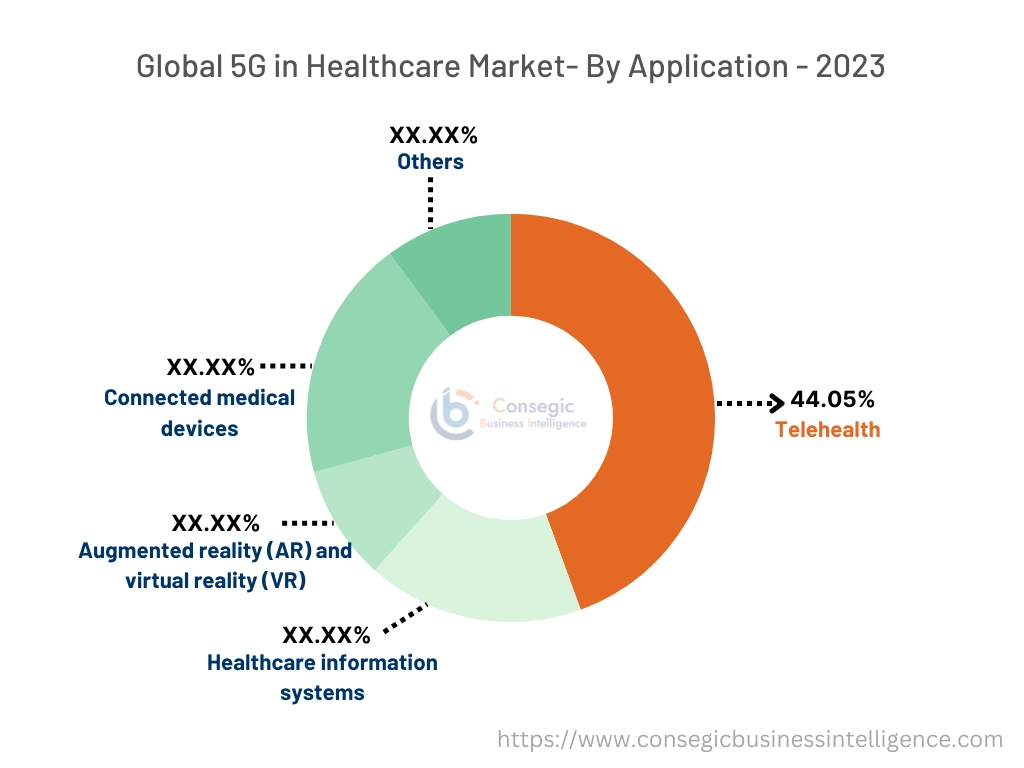
By End-User :
Based on end users, the market is categorized into healthcare providers, healthcare payers, and others.
Trends in the End-User:
- Growing emphasis on patient engagement and communication tools is a trend influencing the adoption of 5G networks.
- Rising demand for personalized healthcare is supporting the integration of 5G networks.
The healthcare provider segment accounted for the largest market share in the year 2023.
- Healthcare providers serve as primary end-users of 5G in the healthcare industry. Integration of 5G enables unprecedented capabilities in patient care delivery, diagnostic procedures, and overall healthcare management. Healthcare providers ranging from large hospital networks to individual clinics leverage 5G's ultra-high bandwidth, minimal latency, and massive device connectivity to transform healthcare delivery.
- 5G is widely employed for hospital system implementation, clinic operations enhancement, remote patient care capabilities, and emergency response & critical care among others.
- Additionally, the prospect of improved patient outcomes and operational efficiencies offered by innovative application cases is driving healthcare organizations to make the requisite investments in 5G technology.
- For instance, according to the data published by Inc. in May 2022, it is stated that approximately three out of four healthcare providers reported plans to pilot or deploy 5G through 2023; 7.8% of respondents stated that they were in production in 2021 and 12.3% will be in production in 2022.
- Adopting new approaches to connectivity using 5G technology increases business resilience through a variety of telehealth initiatives. Moreover, 5G also plays a pivotal role in improving emergency care such as connected ambulances. Overall, healthcare providers are the primary users of 5G.
The others are expected to grow at the fastest CAGR over the forecast period.
Other segments includes diagnostic centers, pharmaceutical & medical device companies, and others.
- 5G technology, with its high speed, low latency, and massive connectivity capabilities, is advancing the healthcare sector. Diagnostic centers benefit from real-time remote consultations, rapid data transfer for timely analysis, and remote patient monitoring.
- Research organizations are able to accelerate research processes, collaborate seamlessly across distances, and leverage AI-powered analysis. Employing 5G technology allows pharmaceutical companies to conduct remote clinical trials, optimize supply chains, and enable precision medicine through data-driven insights.
- Additionally, the utilization of 5G helps medical device companies to develop advanced devices, deploy telemedicine solutions, and leverage data-driven innovation.
- For instance, in July 2022, GE Healthcare, launched its 5G Innovation Lab in Bengaluru, India. This facility leverages the power of 5G technology to revolutionize patient care by enabling faster diagnosis, more effective therapies, and improved prognoses. By providing state-of-the-art infrastructure, including a private 5G network, the lab fosters collaboration between academia, healthcare industry experts, and startups.
- Thus, 5G is influencing the delivery of more efficient, effective, and personalized healthcare solutions.
Regional Analysis:
The regional segment includes North America, Europe, Asia Pacific, the Middle East and Africa, and Latin America.
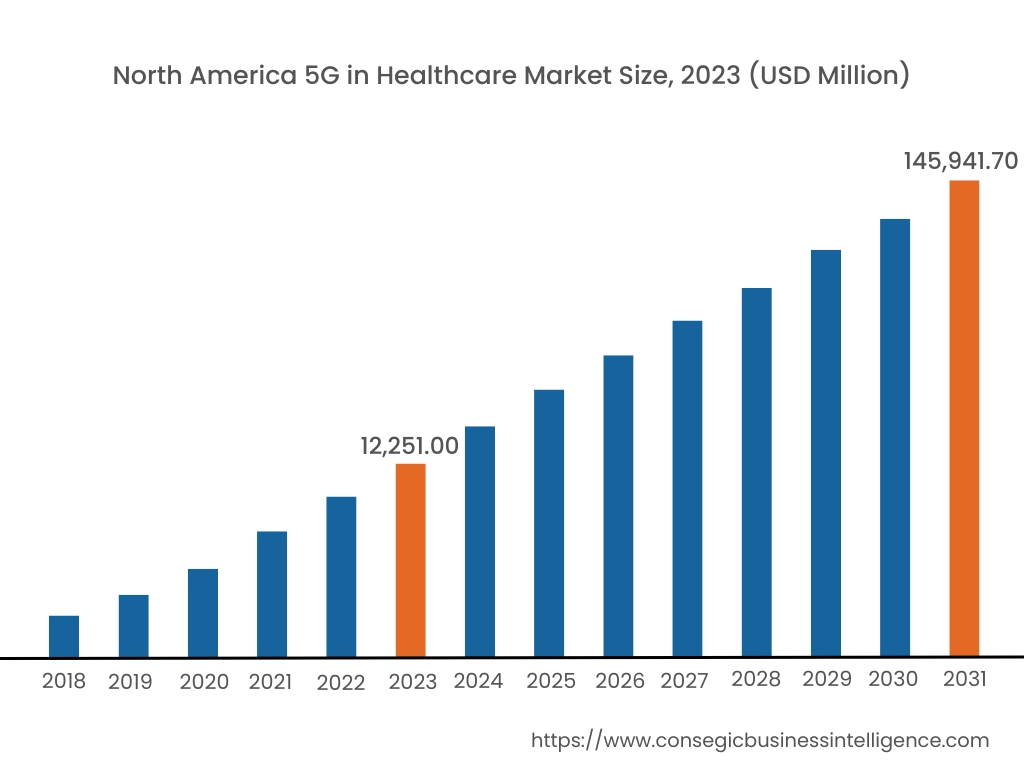
In 2023, North America accounted for the highest market value at 37.34% and was valued at USD 12,251.00 Million in 2023 and is expected to reach USD 145,941.70 Million in 2031. In North America, the U.S. accounted for the highest market share of 79.26% during the base year of 2023. The 5G in the healthcare market share is gaining a significant rise in North America owing to the confluence of multiple factors. The accelerated adoption of digitalization in healthcare services in North America is a key factor. North America boasts a robust technological infrastructure, with significant investments in 5G network deployment and digital health initiatives. This advanced infrastructure provides the foundation for the adoption of 5G-enabled healthcare solutions. Additionally, Government agencies in the U.S. and Canada have recognized the potential of 5G technology to revolutionize healthcare.
- For instance, Federal Communications Commission announced plans to distribute as much as USD 9 billion through the Universal Service Fund to establish 5G wireless broadband connectivity in rural parts of the country, giving healthcare providers and consumers a better foundation for telehealth and mHealth.
Moreover, North America boasts a robust healthcare infrastructure with advanced diagnostic and treatment facilities, leading to requirements for 5G connectivity. North America also presents leading healthcare providers, technology companies, and research institutions. These organizations are actively investing in 5G-enabled healthcare solutions, driving innovation and market growth.
Overall, North America's robust technological infrastructure, supportive government policies, early adoption of telehealth, presence of key industry players, and focus on patient-centric care are collectively driving the growth of the 5G in healthcare market trend in the region.
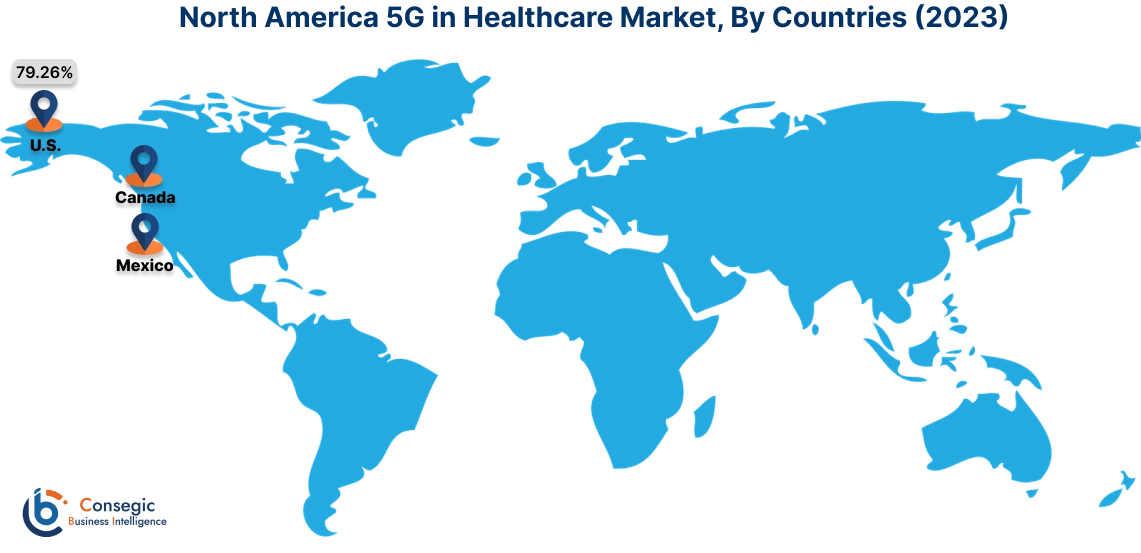
The Asia-Pacific is experiencing the fastest growth for the market, with a CAGR of 40.65% over the forecast period. The share is attributed to factors such as rising healthcare expenditure and improvements in healthcare infrastructure. As the healthcare infrastructure develops it increases awareness about the benefits associated with the adoption of 5G connectivity. Governments, healthcare organizations, and healthcare providers across the region are actively promoting the adoption of 5G technology. This includes investments in 5G infrastructure, regulatory reforms, and supportive policies to encourage innovation and digital transformation further.
- For instance, in October 2024, Tech and health leaders discussed the diverse applications of 5G in healthcare during the HIMSS Asia-Pacific Conference in Seoul. Remote surgeries, holographic medical imaging, mixed reality, and patient tracking are some of the emerging 5G-powered healthcare innovations in the Asia-Pacific region. The conference aimed for the provision of 5G in healthcare across the region.
Europe boasts well-established healthcare systems with a focus on innovation and patient care. The integration of 5G technology into healthcare further enhances the quality and efficiency of these systems. Additionally, Europe has a robust technological infrastructure, with many countries leading in 5G network deployment. This provides a strong foundation for the adoption of 5G-enabled healthcare solutions. Moreover, the region is increasingly investing in digital health initiatives, including the development of digital health records, wearable devices, and AI-powered healthcare solutions. Collectively these factors are supporting the 5G in healthcare market demand across Europe.
The Middle East and Africa region is witnessing a notable surge in the 5G in healthcare market. The burgeoning healthcare sector in the Middle East is playing a pivotal role in driving demand. Many countries in the MEA region are investing in developing their healthcare infrastructure fueled by increasing disposable incomes, aging populations, and the rising prevalence of chronic diseases. This increased spending is driving the demand for advanced healthcare solutions, including 5G-powered technologies. Moreover, initiatives to modernize healthcare systems, improve access to care, and enhance patient outcomes, growing interest in preventative care strategies, and an openness to deploying emerging technologies, are fueling the requirements for 5G-powered solutions in the region.
Latin America is an emerging region in the 5G in healthcare market. The region faces increasing healthcare costs and inefficiencies in traditional healthcare delivery models. 5G technology offers a promising solution to address these challenges by enabling remote patient monitoring, telemedicine, and real-time data exchange. The rising middle class in Latin America is driving demand for better healthcare services. Increased awareness of health issues and a desire for advanced medical treatments are further fueling the growth of the 5G healthcare market. The region's existing healthcare challenges, coupled with the transformative potential of 5G technology, are poised to drive significant growth.
Top Key Players & Market Share Insights:
The 5G in healthcare market is highly competitive with major players providing precise measurements between objects to the national and international markets. Key players are adopting several strategies in product innovation to hold a strong position in the global 5G in healthcare market analysis. Key players in the 5G in healthcare industry include-
- Verizon(United States)
- Telefonaktiebolaget LM Ericsson (Sweden)
- T‑Mobile USA, Inc. (U.S.)
- Qualcomm Technologies, Inc. (U.S.)
- Telefónica S.A. (Spain)
- TELUS (Canada)
- AT&T Intellectual Property (U.S.)
- Samsung (South Korea)
- BT Group (UK)
- Cisco Systems, Inc. (U.S.)
Recent Industry Developments :
Partnerships and Collaborations:
- In September 2024, True Corp announced the collaboration with Intel to launch seven new smart healthcare solutions that leverage 5G connectivity and AI to improve diagnosis, treatment, rehabilitation, and patient data management in hospitals and healthcare agencies in Thailand.
- In April 2022, Bharti Airtel, partnered with Apollo Hospitals and Cisco to create a 5G Connected Ambulance. The custom-designed 5G Connected Ambulance is equipped with the latest medical equipment, patient monitoring applications, and telemetry devices that transmit patient health data to the hospital in real-time. In addition, it is also equipped with onboard cameras, camera-based Headgear, and Bodycams for paramedic staff – all connected to the ultra-fast & low-latency Airtel 5G network. It will be further enabled with technologies like AR/VR.
- In 2023, Verizon Business and KPMG LLP collaborated as part of their alliance relationship to deliver 5G solutions designed to help transform the healthcare and life sciences sectors.
Expansion:
- In July 2022, GE Healthcare, a medical technology company launched its 5G Innovation Lab in Bengaluru, India, the first for GE Healthcare across the globe. This cutting-edge facility leverages the power of 5G technology to revolutionize patient care by enabling faster diagnosis, more effective therapies, and improved prognoses.
New Launch:
- In June 2024, Gleneagles BGS Hospital, Kengeri announced the launch of reportedly South India's first 5G-enabled ambulance service. In the initial phase, five 5G-enabled ambulances will cover the immediate neighborhood of the hospital, while the second phase will see an additional five ambulances extending coverage to neighboring districts, further enhancing emergency response capabilities across the region.
5G in Healthcare Market Report Insights :
- Telehealth
- Healthcare Information Systems
- Augmented Reality (AR) and Virtual Reality (VR)
- Connected Medical Devices
- Others
| Report Attributes | Report Details |
| Study Timeline | 2018-2031 |
| Market Size in 2031 | USD 428,781.16 Million |
| CAGR (2024-2031) | 37.93% |
| By Treatment |
|
| By Application |
|
| By End-User |
|
| By Region |
|
| Key Players |
|
| North America | U.S. Canada Mexico |
| Europe | U.K. Germany France Spain Italy Russia Benelux Rest of Europe |
| APAC | China South Korea Japan India Australia ASEAN Rest of Asia-Pacific |
| Middle East and Africa | GCC Turkey South Africa Rest of MEA |
| LATAM | Brazil Argentina Chile Rest of LATAM |
| Report Coverage |
|
Key Questions Answered in the Report
How big is the 5G in Healthcare Market? +
In 2023, the 5G in Healthcare market was valued at USD 32,809.32 Million.
Which is the fastest-growing region in the 5G in Healthcare market? +
Asia Pacific is the fastest-growing region in the 5G in Healthcare market.
What specific segmentation details are covered in the 5G in Healthcare Market? +
Component, Application, and End-user segmentation details are covered in the 5G in Healthcare Market.
